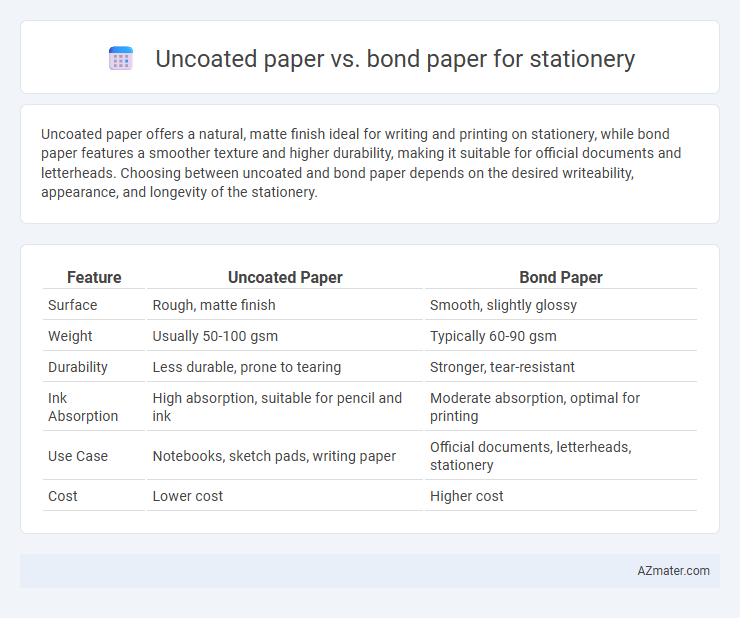Uncoated paper offers a natural, matte finish ideal for writing and printing on stationery, while bond paper features a smoother texture and higher durability, making it suitable for official documents and letterheads. Choosing between uncoated and bond paper depends on the desired writeability, appearance, and longevity of the stationery.
Table of Comparison
| Feature | Uncoated Paper | Bond Paper |
|---|---|---|
| Surface | Rough, matte finish | Smooth, slightly glossy |
| Weight | Usually 50-100 gsm | Typically 60-90 gsm |
| Durability | Less durable, prone to tearing | Stronger, tear-resistant |
| Ink Absorption | High absorption, suitable for pencil and ink | Moderate absorption, optimal for printing |
| Use Case | Notebooks, sketch pads, writing paper | Official documents, letterheads, stationery |
| Cost | Lower cost | Higher cost |
Introduction to Uncoated Paper and Bond Paper
Uncoated paper is a type of paper that lacks a surface coating, offering a natural, textured feel ideal for printing stationery like letterheads and envelopes. Bond paper is a high-quality, durable paper commonly used for official documents and stationery, characterized by its strong fiber content and smooth finish. Both papers serve distinct purposes in stationery, with uncoated paper favored for its tactile quality and bond paper prized for its professional appearance and strength.
Defining Uncoated Paper
Uncoated paper features a natural, porous surface without any finishing layer, providing excellent ink absorption and a tactile feel ideal for stationery applications like letterheads and invitations. Bond paper, often smoother and stronger due to its cotton or synthetic fiber content, is commonly used for everyday printing and business documents. Choosing uncoated paper enhances the authenticity and classic appeal of stationery while ensuring superior writeability with various writing instruments.
What is Bond Paper?
Bond paper is a durable, high-quality writing paper commonly used for stationery, official documents, and letterheads, known for its strength and smooth surface. Unlike uncoated paper, bond paper often contains cotton fibers, enhancing its durability and resistance to wear and tear. Its bright white color and weight typically range between 16 to 36 pounds, making it ideal for professional printing and writing applications.
Key Differences Between Uncoated Paper and Bond Paper
Uncoated paper features a rougher texture and higher absorbency, making it ideal for handwritten notes and printing where ink absorption is crucial, while bond paper is smoother, stronger, and designed for professional documents like letterheads and stationery requiring durability. Uncoated paper generally has a matte finish without a coating layer, resulting in less glare, whereas bond paper often includes a slight coating that enhances ink retention and print clarity. Weight differences also matter: uncoated papers typically range from 50 to 100 gsm, whereas bond papers are heavier, commonly between 60 to 120 gsm, providing better stiffness suited for formal stationery.
Texture and Appearance Comparison
Uncoated paper features a rougher texture with a natural, matte finish that enhances the tactile experience, making it ideal for stationery requiring a classic or artisanal look. Bond paper offers a smoother, more uniform surface with a bright white appearance, providing crisp, sharp print quality often preferred for professional documents and letterheads. The choice between uncoated and bond paper significantly impacts the sensory feel and visual impression of stationery, influencing both user experience and brand perception.
Writing Experience: Uncoated vs Bond Paper
Uncoated paper offers a smooth, natural texture that enhances pen grip and ink absorption, making it ideal for handwritten notes and calligraphy. Bond paper typically has a slightly coated finish, allowing for sharper ink definition and less bleed-through, preferred in professional correspondence. The choice between uncoated and bond paper directly impacts the tactile feel and clarity of writing on stationery.
Print Quality and Ink Absorption
Uncoated paper offers a rougher texture that enhances ink absorption, resulting in vibrant colors and sharp, detailed prints ideal for stationery requiring high print quality. Bond paper, while smoother and less absorbent, provides a crisp, clean surface that minimizes ink bleed but may produce less saturated colors. Choosing between uncoated and bond paper depends on the desired balance between vivid print quality and precise ink control for stationery applications.
Durability and Strength Considerations
Uncoated paper, characterized by its natural, porous surface, offers moderate durability but tends to absorb ink more readily, which can affect print quality and long-term strength. Bond paper is engineered for higher durability and tensile strength, making it ideal for stationery that demands frequent handling and writing, as it resists tearing and maintains structural integrity over time. Choosing between uncoated and bond paper depends on the balance between aesthetic preference and the need for robust, long-lasting stationery materials.
Ideal Uses for Uncoated and Bond Paper in Stationery
Uncoated paper, favored for its natural texture and superior ink absorption, is ideal for stationery requiring a classic, elegant feel such as letterheads, envelopes, and personalized notepads. Bond paper offers enhanced durability and a smooth finish, making it perfect for professional documents, forms, and business stationery that demand crisp, legible printing. Both papers serve unique stationery needs: uncoated excels in tactile appeal while bond ensures longevity and clarity.
Choosing the Right Paper for Your Stationery Needs
Selecting the right paper for your stationery depends on the purpose and desired aesthetic; uncoated paper offers a natural texture ideal for a classic, elegant look, while bond paper provides a smooth finish suitable for professional documents and everyday use. Uncoated paper's porous surface enhances ink absorption, making it perfect for writing with fountain pens and creating a tactile experience. Bond paper's durability and resistance to smudging are advantageous for letterheads, forms, and printed materials requiring crisp, clear text.

Infographic: Uncoated paper vs Bond paper for Stationery
 azmater.com
azmater.com